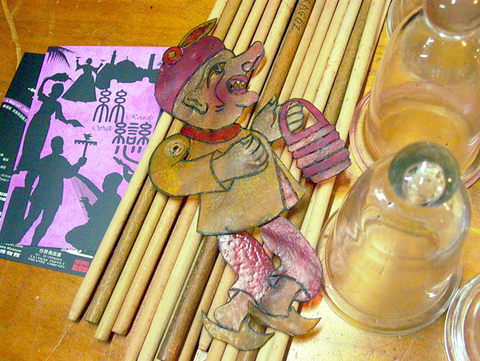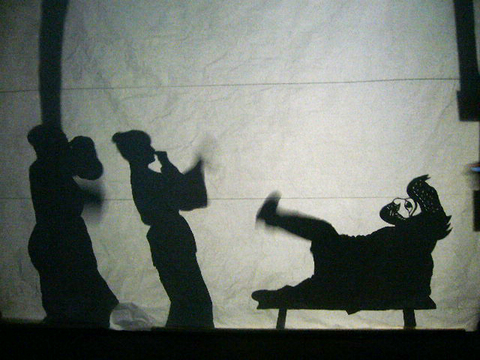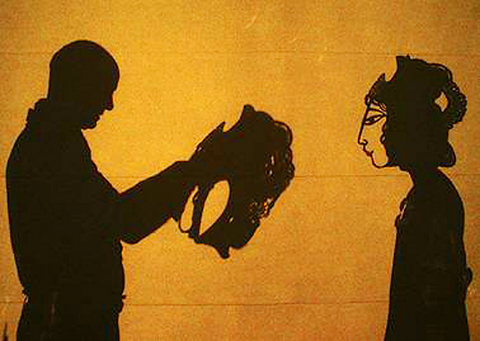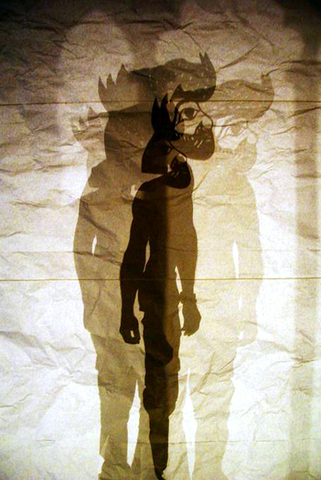At a small theater on Taipei's west side, Taiwan's foremost puppeteer Chen Xi-huang (陳錫煌) adds a few finishing touches to his glove puppets while the Turkish shadow puppet master Cengiz Ozek discusses how to present the show with stagehands and Robin Ruizendaal, art director of Taiyuan Puppet Theater Company (台原偶戲團).
Fittingly, the international collaboration is about an adventure on the silk road, the ancient cultural highway linking Asia and Europe, as artists and musicians from Taiwan, Turkey and the US contribute their inspiration to the interdisciplinary production combining Taiwan's glove puppet and Turkish shadow puppet theaters, live performances and large shadow screen performances directed by Larry Reed, founder of the Shadowlights Company of San Francisco. (see story below.)
Silk Road (絲戀) tells of the story of two sisters traveling through the silk road from China to Istanbul to find a magical harp that charms silkworms to produce the most beautiful colored silk in the world. From mountain, desert to oasis and spice fair, the girls encounter all kinds of exotic animals, magicians, human traffickers, belly dancers, poets, sages and hobgoblins on their journey.

PHOTOS COURTESY OF TAIYUAN PUPPET THEATER COMPANY
To Ruizendaal and Ozek, the show is a theatrical celebration and exploration of the ancient cultural exchanges that have left an indelible imprint on today's world. "One of my key interests for the play is to see the shared affinity of puppetry traditions in China, Turkey, Egypt and Taiwan," said Ozek, art director of Istanbul International Puppet Festival.
A unique and innovative experiment, the production is presented on three stages, one designed for actors, the other two for glove and shadow puppetry. Reed builds on this with his light show, that creates a world of amazing shadows, overlapping images and the illusion of depth.
As for the music, Taiwan's award-winning composer Li Che-i (李哲藝) will team up with Turkish musicians Binnaz Celik and Gunay Celik to stage live performances of the original score mixing Turkish folk songs and traditional Chinese music.

"Our biggest challenge is to integrate all the diverse elements into one coherent play," said Ruizendaal, adding that the production is a first-time attempt to every one involved.
Also new is the ensemble's attempt to offer a lively introduction to the ancient theatrical tradition in Turkey, its exquisite marionettes made out of camel skin and the beloved puppet figure Karagoz, a playful jester who undergoes different transformations in different stories that come from the grassroots culture as a manifestation of the people's voices, ideas and lives.
Having studied shadow puppet theater since age 11 and played Karagoz for the past 30 years, Ozek is excited to bring life to his favorite character not only through his accomplished puppetry art but as a real human performance on the stage. "I always feel myself as Karagoz. In the shadow puppet theater, I am connected with Karagoz with two sticks, but now for the first time, I am Karagoz," said Ozek, who will bring this creative production to Istanbul International Puppet Festival in May.



This month the government ordered a one-year block of Xiaohongshu (小紅書) or Rednote, a Chinese social media platform with more than 3 million users in Taiwan. The government pointed to widespread fraud activity on the platform, along with cybersecurity failures. Officials said that they had reached out to the company and asked it to change. However, they received no response. The pro-China parties, the Chinese Nationalist Party (KMT) and Taiwan People’s Party (TPP), immediately swung into action, denouncing the ban as an attack on free speech. This “free speech” claim was then echoed by the People’s Republic of China (PRC),

Exceptions to the rule are sometimes revealing. For a brief few years, there was an emerging ideological split between the Democratic Progressive Party (DPP) and Chinese Nationalist Party (KMT) that appeared to be pushing the DPP in a direction that would be considered more liberal, and the KMT more conservative. In the previous column, “The KMT-DPP’s bureaucrat-led developmental state” (Dec. 11, page 12), we examined how Taiwan’s democratic system developed, and how both the two main parties largely accepted a similar consensus on how Taiwan should be run domestically and did not split along the left-right lines more familiar in

Specialty sandwiches loaded with the contents of an entire charcuterie board, overflowing with sauces, creams and all manner of creative add-ons, is perhaps one of the biggest global food trends of this year. From London to New York, lines form down the block for mortadella, burrata, pistachio and more stuffed between slices of fresh sourdough, rye or focaccia. To try the trend in Taipei, Munchies Mafia is for sure the spot — could this be the best sandwich in town? Carlos from Spain and Sergio from Mexico opened this spot just seven months ago. The two met working in the

Many people in Taiwan first learned about universal basic income (UBI) — the idea that the government should provide regular, no-strings-attached payments to each citizen — in 2019. While seeking the Democratic nomination for the 2020 US presidential election, Andrew Yang, a politician of Taiwanese descent, said that, if elected, he’d institute a UBI of US$1,000 per month to “get the economic boot off of people’s throats, allowing them to lift their heads up, breathe, and get excited for the future.” His campaign petered out, but the concept of UBI hasn’t gone away. Throughout the industrialized world, there are fears that